ScalaSchool
Classes
Classes in Scala are very similar to classes in Java.
They are templates containing fields and methods. Like in Java, classes can be instantiated using the new construct, there can be many “instances” (or “objects”) of the same class.
In Scala there exists a special kind of class named case classes We’ll take about those later.
Classes in Scala cannot have static members. You can use Objects (see below) to achieve similar functionality as with static members in Java.
Class Definitions
class MyClass(x: Int, val y: Int) { // Defines a new type MyClass with a constructor
// m.y is defined as a field. x isn't accessible outside the class
this() { this(1,1) } // Auxiliary constructor
require(y > 0, "y must be positive") // precondition, triggering an IllegalArgumentException if not met
def nb1 = x // public method computed every time it is called
def nb2 = y
private def test(a: Int): Int = { ... } // private method
val nb3 = x + y // computed only once
override def toString = // overridden method
member1 + ", " + member2
}
new MyClass(1, 2) // creates a new object of type
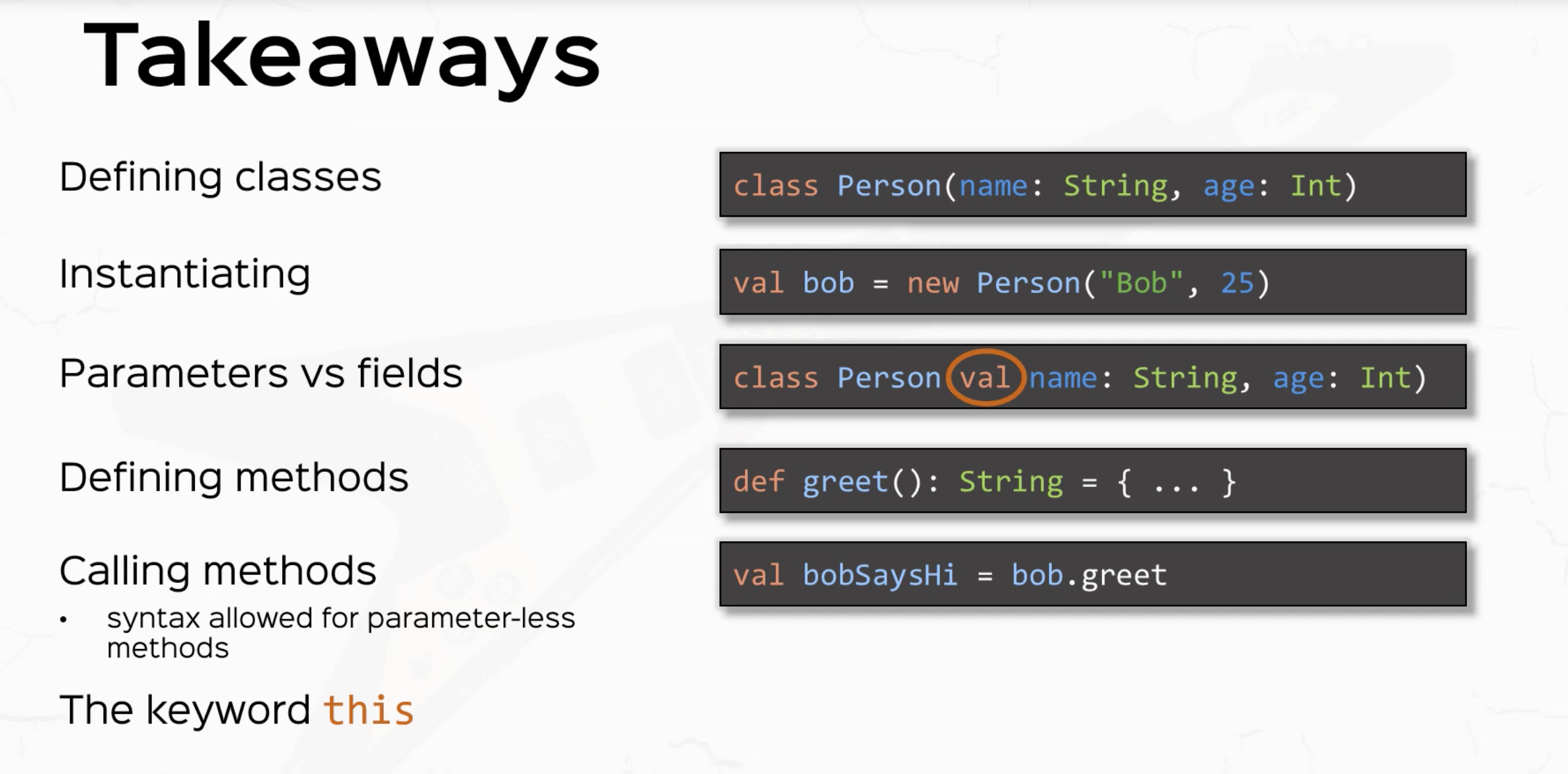
Inheritance
class Employee(name: String) extends Person(name) {
// Calls the primary constructor of superclass
var salary = 0.0
override def toString = super.toString + s"[salary=$salary]"
// Use override when overriding a method
}
Java Type operations on Scala classes
// You *can* do Java like type operations (but usually Scala has better alternatives
if(p.isInstanceOf[Employee]) { // Java isInstanceOf
val e = p.asInstanceOf[Employee] // Like a Java cast
}
if(p.getClass == classOf[Employee]) ... // Like Java Employee.class
// Again you normally will use pattern matching instead of doing this type of thing
Class methods
A method is a function that is a member of some class, trait, or singleton object. Scala has some interesting syntactic sugar to make calling methods more like natural language syntax.
a bis equivalent toa.ba b cis equivalent toa.b(c), except when b ends in:In that case,a b cis equivalent toc.b(a)- Remember
:at the end of a method name is for right associativity! a(b)is equivalent toa.apply(b)This is why the following definitions for an anonymous functions are identical:val square1 = (x: Int) => x*x val square2 = new Function1[Int,Int] { def apply(x: Int) = x*x }When calling
square1(y), you are actually callingsquare1.apply(y)whichsquare1must have as specified by the Function1 trait (or Function2, etc…)-
a(b) = cis equivalent toa.update(b,c). Likewise,a(b,c) = dis equivalent toa.update(b,c,d)and so on a.b = cis equivalent toa.b_=(c). When you create aval/var xin a Class/Object, Scala creates the methodsxandx_=for you. You can define these yourself, but if you definey_=you must defineyor it will not compile, for example:
scala> val b = new Object{ def set_=(a: Int) = println(a) }
b: java.lang.Object{def set_=(Int): Unit} = $anon$1@17e4cec
scala> b.set = 5
<console>:6: error: value set is not a member of java.lang.Object{def set_=(Int): Unit}
b.set = 5
^
scala> val c = new Object{ def set = 0 ; def set_=(a:Int) = println(a) }
c: java.lang.Object{def set: Int; def set_=(Int): Unit} = $anon$1@95a253
scala> c.set = 5
5
Operator Notation
Infix Operators
You can write a identifier b where identifier denotes a method with two parameters
(one implicit, one explicit). For example:
1 to 10
is actually a method call:
1.to(10)
This is called an infix expression because the operator is between the arguments.
Unary Operators
-a corresponds to a.unary_-. Likewise for +a,~a, and !a
Assignment Operators
a <operator>= b is equivalent to a = a <operator> b e.g.
class test(val x:Int) {
def %%(y: Int) = new test(x*y)
}
var a = new test(10)
a.x // 10
a %%= 5 // Equivalent to a = a %% 5
a.x // 50
Notes on Assignment Operators:
- <=, >=, and != are NOT assignment operators
- An operator starting with =, is never an assignment operator (==, ===. =/= etc.)
- If
ahas a method calledoperator=, then that method is called directly
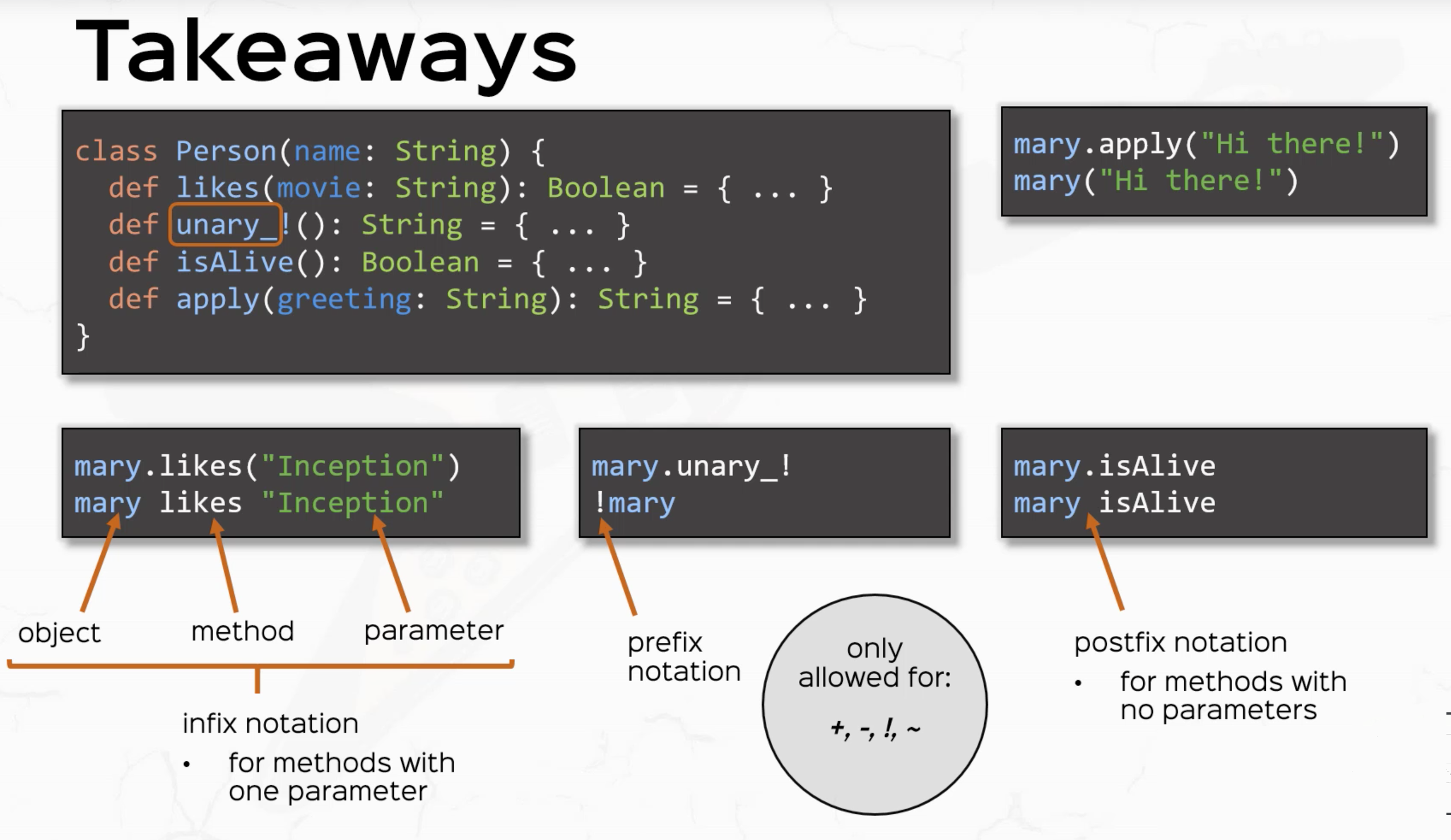
Traits
Traits are like interfaces in Java, but they can also contain concrete members, i.e. method implementations or field definitions.
trait Logger { // Traits can't have constructors
def log(msg: String) // abstract method
def info(msg: String) = log(s"INFO $msg") // traits can have concrete methods too
}
class App extends Logger with Auth { ... } // Mix in any number of traits
trait TimestampLogger extends Logger { // Traits can extend Traits too
abstract override def log(msg: String) = { // Still abstract!
super.log(s"${System.currentTimeMillis} $msg")
}
}
trait ConsoleLogger extends Logger {
override def log(msg: String): Unit = println(msg)
}
object App extends ConsoleLogger with TimestampLogger
// App.log("Hi") calls log of LAST Trait mixed in; super.log calls the super of that trait
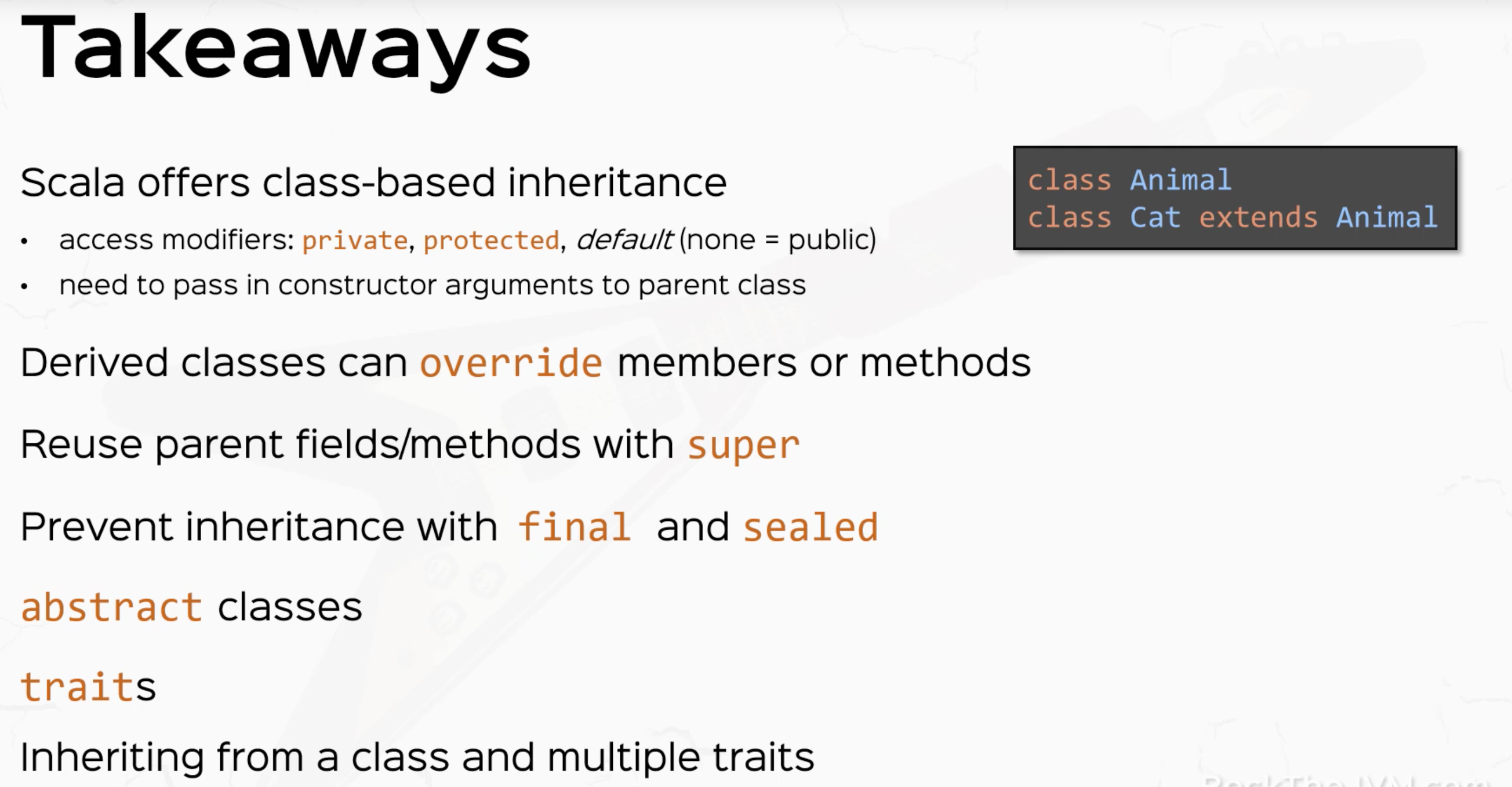
Objects
Object in Scala are like classes, but for every object definition there is only one single instance. It is not possible to create instances of objects using new, instead you can just access the members (methods or fields) of an object using its name.
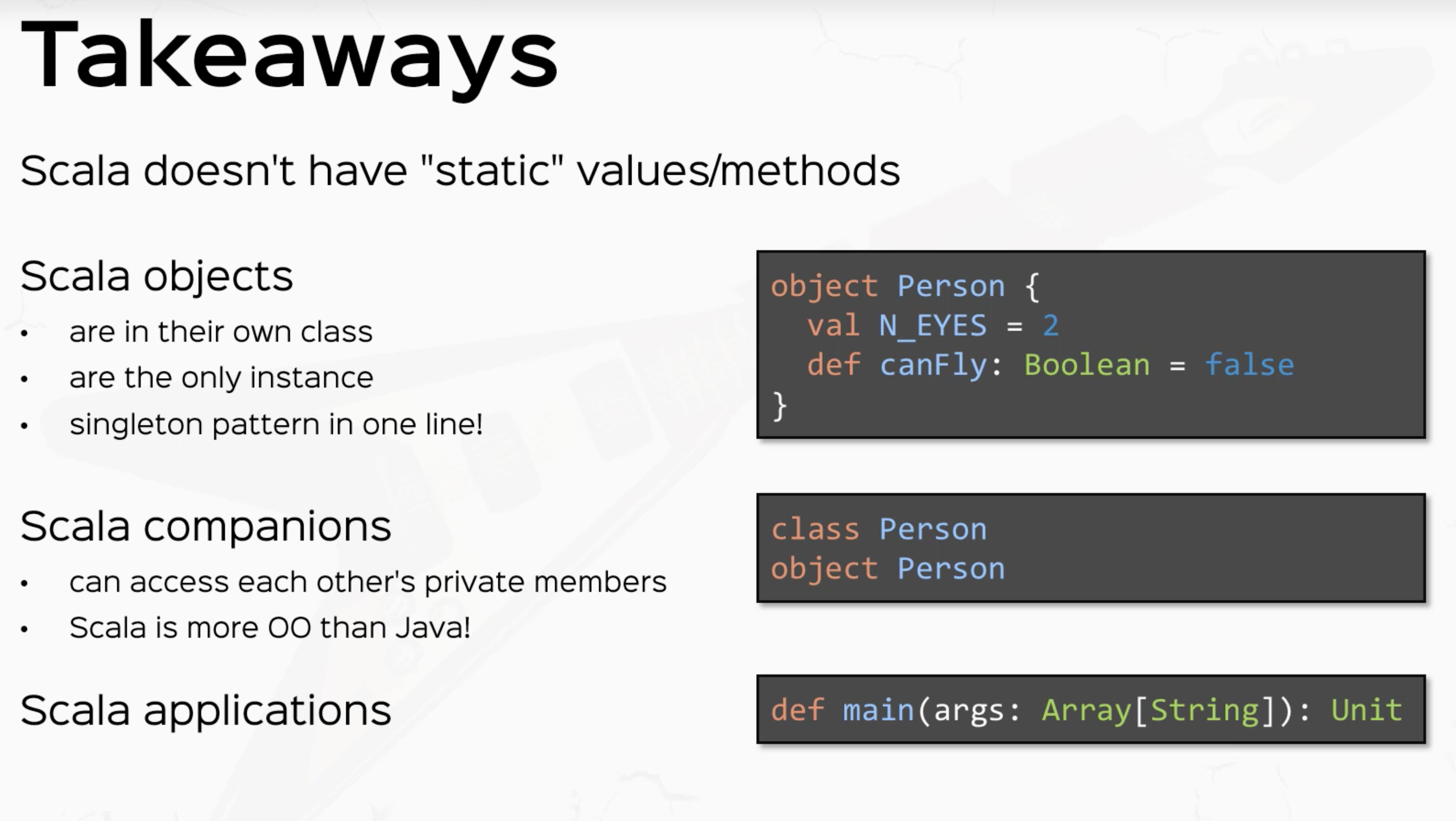
Packages
Adding a statement such as package foo.bar at the top of a file makes the code in a file part of the package foo.bar.
You can then do import foo.bar._ to make everything from package foo.bar available in your code. The content of a
package can be scattered across many files. If you define a class MyClass in package foo.bar, you can import that
specific class (and not anything else from that package) with import foo.bar.MyClass.
In Scala, everything can be imported, not only class names. So for instance if you have an object baz in package
foo.bar, then import foo.bar.baz._ would import all the members of that object.
import package_name.{A, B} // imports A and B from the package called `package_name`
import package_name._ // imports everything from the package called `package_name`
import package_name.{A => B} // imports A from the package called `package_name` and aliases it as B
// This can be useful if you want to import 2 classes that have the same name.
import package_name.{List => _, _} // imports everything *except* List
// scala, scala.Predef, and java.lang are always imported
def square(x): Double = {
import scala.math._ // imports can be inside blocks
pow(x,2)
}
import math._ // same as import scala.math._ Imports nest in Scala
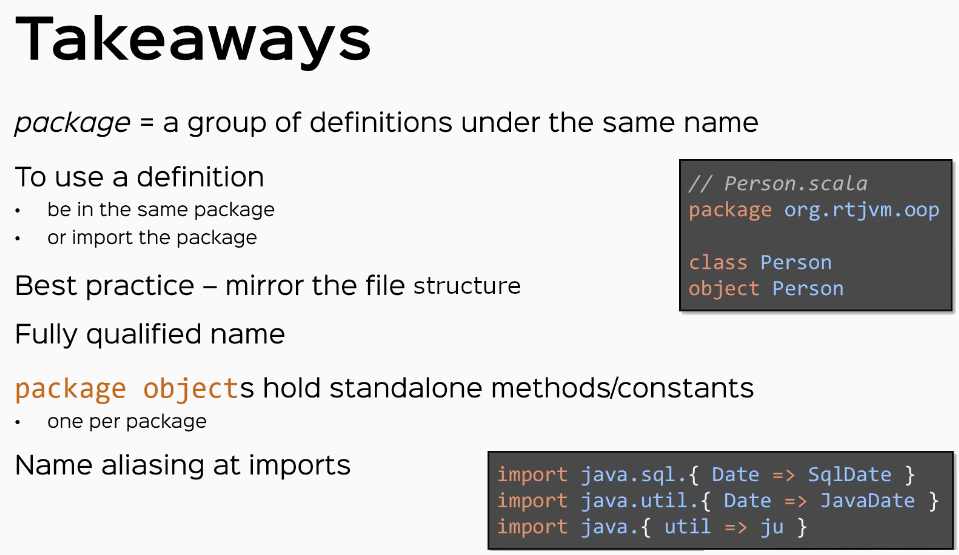
Class hierarchies
abstract class TopLevel { // abstract class
def method1(x: Int): Int // abstract method
def method2(x: Int): Int = { ... }
}
class Level1 extends TopLevel {
def method1(x: Int): Int = { ... }
override def method2(x: Int): Int = { ...} // TopLevel's method2 needs to be explicitly overridden
}
object MyObject extends TopLevel { ... } // defines a singleton object. No other instance can be created
Class Organization
-
Classes and objects are organized in packages (
package myPackage). -
They can be referenced through import statements (
import myPackage.MyClass,import myPackage._,import myPackage.{MyClass1, MyClass2},import myPackage.{MyClass1 => A}) -
They can also be directly referenced in the code with the fully qualified name (
new myPackage.MyClass1) -
All members of packages
scalaandjava.langas well as all members of the objectscala.Predefare automatically imported. -
General object hierarchy:
scala.Anybase type of all types. Has methodshashCodeandtoStringthat can be overriddenscala.AnyValbase type of all primitive types. (scala.Double,scala.Float, etc.)scala.AnyRefbase type of all reference types. (alias ofjava.lang.Object, supertype ofjava.lang.String,scala.List, any user-defined class)scala.Nullis a subtype of anyscala.AnyRef(nullis the only instance of typeNull)scala.Nothingis a subtype of any other type without any instance.
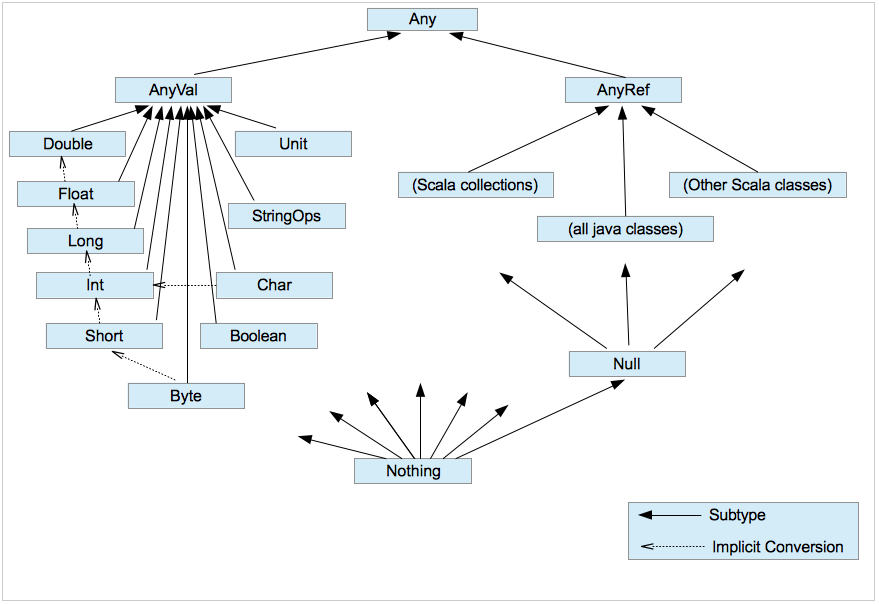
Type Parameters
Conceptually similar to C++ templates or Java generics. These can apply to classes, traits or functions.
class MyClass[T](arg1: T) { ... }
new MyClass[Int](1)
new MyClass(1) // the type is being inferred, i.e. determined based on the value arguments
It is possible to restrict the type being used, e.g.
def myFct[T <: TopLevel](arg: T): T = { ... } // T must derive from TopLevel or be TopLevel
def myFct[T >: Level1](arg: T): T = { ... } // T must be a supertype of Level1
def myFct[T >: Level1 <: Top Level](arg: T): T = { ... }